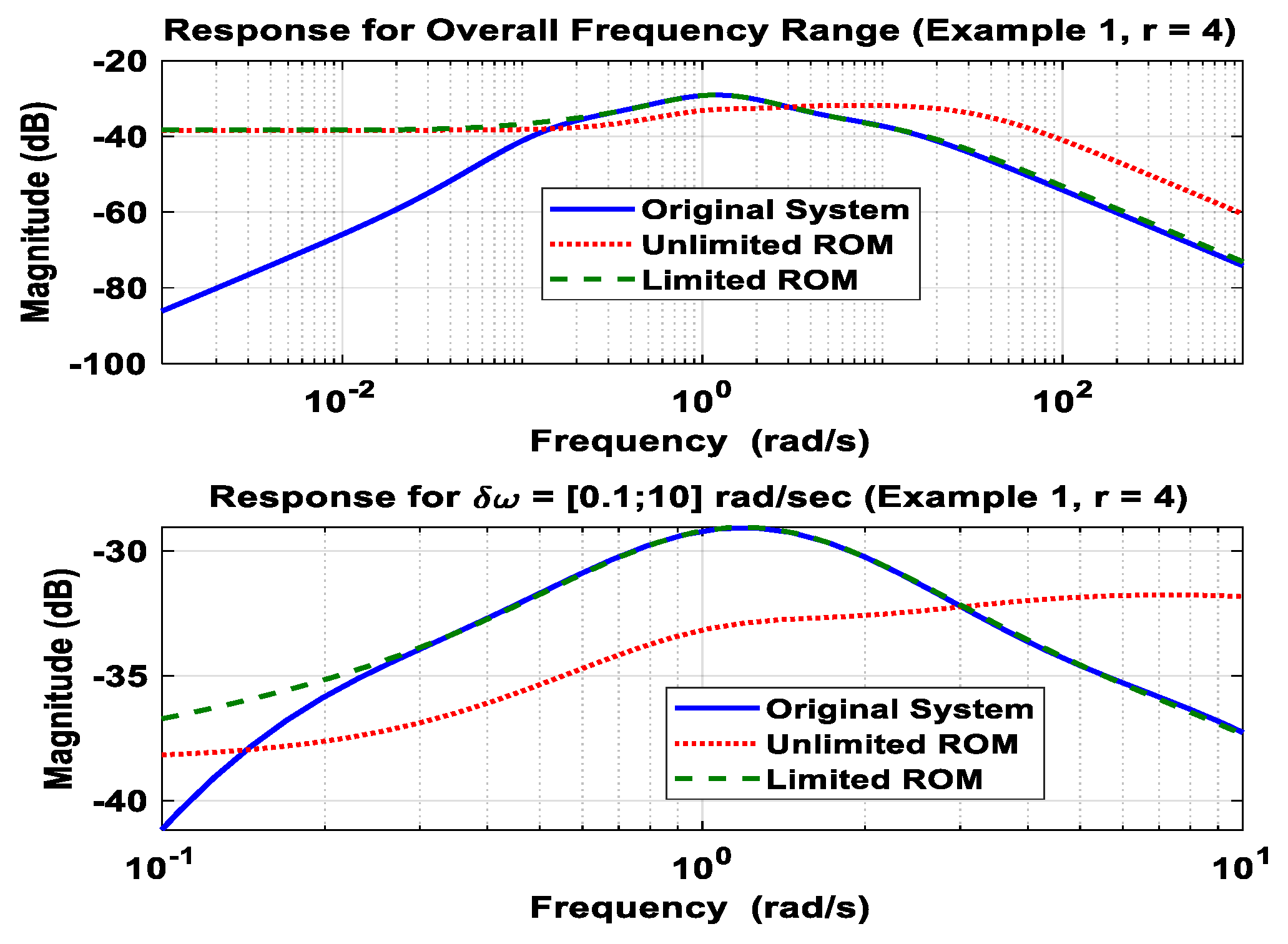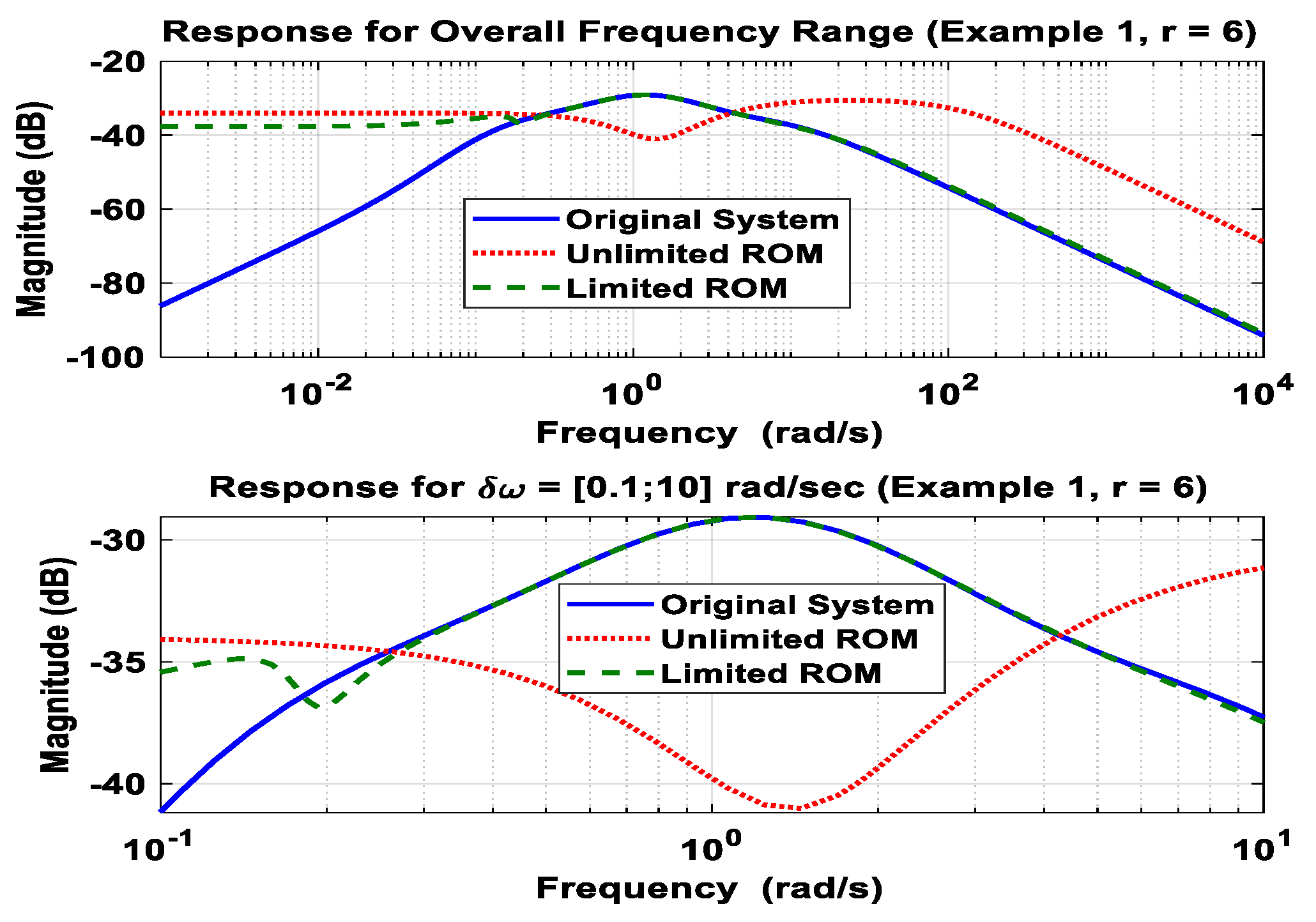Stable Reduced-Order Model for Index-3 Second-Order Systems †
Abstract
:1. Introduction
2. Proposed Technique
2.1. Continous Time Index-3 Second-Order System
2.2. Balanced Truncation for Frequency Limited Second-Order System
3. Results and Discussions
4. Conclusions
Author Contributions
Funding
Institutional Review Board Statement
Informed Consent Statement
Data Availability Statement
Conflicts of Interest
Appendix A
References
- Haider, S.; Ghafoor, A.; Imran, M.; Malik, F.M. Frequency Interval Graminas based Structure Preserving Model Order Reduction for Second Order Systems. Asian J. Control 2018, 20, 790–801. [Google Scholar] [CrossRef]
- Eich-Soellner, E.; Führer, C. Numerical Methods in Multibody Dynamics; Teubner: Stuttgart, Germany, 1998; Volume 45. [Google Scholar]
- Liu, N.; Jeffers, A.E. A geometrically exact isogeometric Kirchhoff plate: Feature-preserving automatic meshing and C1 rational triangular Bézier spline discretizations. Int. J. Numer. Methods Eng. 2018, 115, 395–409. [Google Scholar] [CrossRef]
- Clark, J.V.; Pister, K.S.J. Modified nodal analysis for MEMSwithmulti-energy domains. In Proceedings of the 2000 International Conference on Modeling and Simulation of Microsystems, San Diego, CA, USA, 27–29 March 2000; pp. 1–4. [Google Scholar]
- Hammarling, S.J. Numerical solution of the stable, non-negative definite lyapunov equation lyapunov equation. IMA J. Numer. Anal. 1982, 2, 303–323. [Google Scholar] [CrossRef] [Green Version]
- Uddin, M.M. Computational Methods for Model Reduction of Large-Scale Sparse Structured Descriptor Systems. Doctoral Dissertation, Otto-von-Guericke Universität Magdeburg, Magdeburg, Germany, 2015. [Google Scholar]
- Hossain, M.S.; Omar, S.G.; Tahsin, A.; Khan, E.H. Efficient system reduction modeling of periodic control systems with application to circuit problems. In Proceedings of the 2017 4th International Conference on Advances in Electrical Engineering (ICAEE), Dhaka, Bangladesh, 28–30 September 2017; pp. 259–264. [Google Scholar] [CrossRef]
- Mullis, C.; Richard, R. Synthesis of minimum roundoff noise fixed point digital filters. IEEE Trans. Circuits Syst. 1976, 23, 551–562. [Google Scholar] [CrossRef]
- Gawronski, W.; Juang, J.-N. Model reduction in limited time and frequency intervals. Int. J. Syst. Sci. 1990, 21, 349–376. [Google Scholar] [CrossRef]
- Stykel, T. Gramian-based model reduction for descriptor systems. Math. Control Signals Syst. 2004, 16, 297–319. [Google Scholar] [CrossRef]
- Uddin, M.M. Gramian-based Model Order Reduction of a constrained Structural Dynamic Systems. IET Control Theory Appl. 2018, 12, 2337–2346. [Google Scholar] [CrossRef]
- Imran, M.; Ghafoor, A. Stability preserving model reduction technique and error bounds using frequency-limited Gramians for discrete-time systems. IEEE Trans. Circuits Syst. II Express Brief 2014, 61, 716–720. [Google Scholar] [CrossRef]


| Reduction Order | Eigen Values | ||||||
|---|---|---|---|---|---|---|---|
| 4th | Indefinite/unstable | 8.1052 | −1.8231 | −0.8951 | −0.2564 | ||
| Definite/Stable | −14.6433 + 0.0000i | −1.0199 + 0.6451i | −1.0199 − 0.6451i | −0.1161 + 0.0000i | |||
| 6th | Indefinite/unstable | −14.1601 + 0.0000i | −1.0383 + 0.6254i | −1.0383 − 0.6254i | 0.0745 + 0.1726i | 0.0745 − 0.1726i | −0.1325 + 0.0000i |
| Definite/Stable | −13.6459 + 0.0000i | −1.0232 + 0.6456i | −1.0232 − 0.6456i | −0.0352 + 0.1794i | −0.0352 − 0.1794i | −0.0990 + 0.0000i | |
Publisher’s Note: MDPI stays neutral with regard to jurisdictional claims in published maps and institutional affiliations. |
© 2022 by the authors. Licensee MDPI, Basel, Switzerland. This article is an open access article distributed under the terms and conditions of the Creative Commons Attribution (CC BY) license (https://creativecommons.org/licenses/by/4.0/).
Share and Cite
Rehan, M.; Haider, S.; Huda, A.B.; Saqlain, M.; Hadi, H. Stable Reduced-Order Model for Index-3 Second-Order Systems. Eng. Proc. 2022, 20, 27. https://doi.org/10.3390/engproc2022020027
Rehan M, Haider S, Huda AB, Saqlain M, Hadi H. Stable Reduced-Order Model for Index-3 Second-Order Systems. Engineering Proceedings. 2022; 20(1):27. https://doi.org/10.3390/engproc2022020027
Chicago/Turabian StyleRehan, Mubashir, Shafiq Haider, Aamina Bintul Huda, Muhammad Saqlain, and Hussain Hadi. 2022. "Stable Reduced-Order Model for Index-3 Second-Order Systems" Engineering Proceedings 20, no. 1: 27. https://doi.org/10.3390/engproc2022020027
APA StyleRehan, M., Haider, S., Huda, A. B., Saqlain, M., & Hadi, H. (2022). Stable Reduced-Order Model for Index-3 Second-Order Systems. Engineering Proceedings, 20(1), 27. https://doi.org/10.3390/engproc2022020027






